Damascus steel is renowned for its exceptional strength, sharpness, and distinctive patterns.
The process of creating this steel involves intricate methods that may surprise you.
With a rich history shrouded in mystery and expertise, the allure of Damascus steel continues to fascinate historians and craftsmen alike.
The question of what truly sets Damascus steel apart is one worth exploring.
Key Takeaways
What Is Damascus Steel is a type of steel created by layering different steels, folded and forged to form intricate patterns. It is known for its exceptional edge retention due to its high carbon content and layered structure. The unique blend of hardness and flexibility in Damascus steel provides superior strength and durability. The historical significance of Damascus steel stems from lost techniques and its legendary strength in weaponry. The making process involves precise welding, forging, and shaping techniques to create unique patterns and ensure durability.
What makes Damascus steel special?
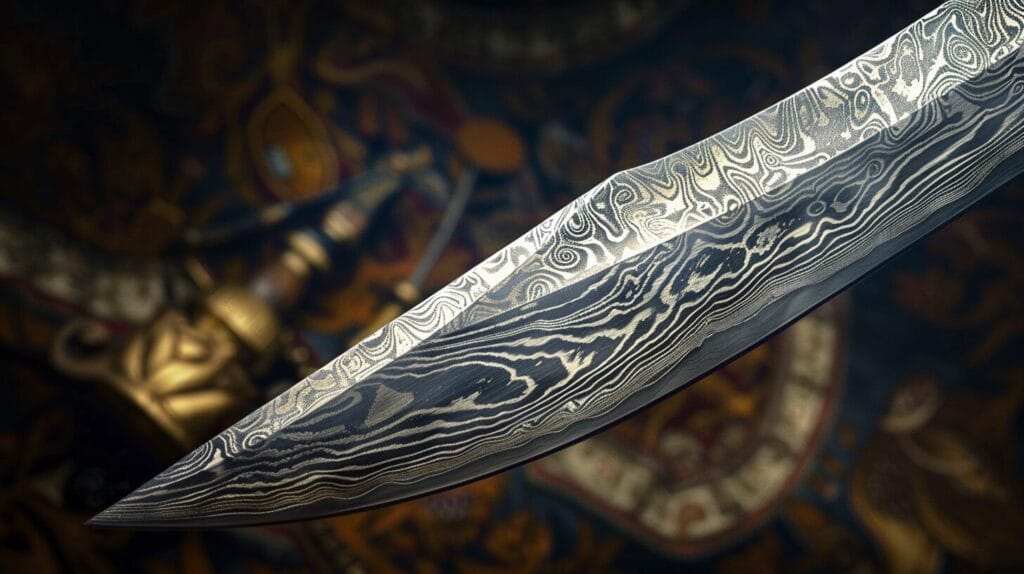
Well, its distinctive patterns and layered construction set it apart from other types of steel. Not only does this construction enhance its strength, but it also contributes to its renowned sharpness.
Moreover, Damascus steel is known for its exceptional edge retention, flexibility, and toughness, making it a preferred choice for blades and cutlery.
Layered Construction
Damascus steel gains its strength and sharpness from the meticulous process of forge-welding alternating layers of high-carbon and low-carbon steel. This unique construction combines hard, high-carbon steel for sharpness with tougher, low-carbon steel for durability, achieving a perfect balance of hardness and resilience. The high-carbon steel contributes to the blade’s cutting ability, while the low-carbon steel adds resistance to breakage. As a result, Damascus steel not only performs well but also showcases the distinctive wavy patterns it’s famous for.
The layers of steel are folded and hammered multiple times, creating hundreds of layers in the final blade. This process removes impurities and ensures a clean material. Additionally, the repeated forging and folding align the steel’s crystalline structure, enhancing its strength and toughness.
The meticulous craftsmanship involved in creating Damascus steel sets it apart and establishes its legendary reputation in the field of bladesmithing.
Distinctive Patterns
The unique swirling patterns found on Damascus steel blades are a result of the folding and welding process used during their creation.
Layers of different types of steel are forged together, and as these metals are repeatedly folded and welded, the intricate patterns emerge on the blade’s surface, creating a visually appealing effect.
Superior Edge Retention
Damascus steel blades are renowned for their exceptional edge retention, thanks to their high carbon content and layered structure. The high carbon content allows for an extremely sharp edge that lasts a long time, while the layered structure helps prevent chipping and rolling of the cutting edge.
This results in long-lasting sharpness and enhanced durability, making Damascus steel blades a reliable choice for various cutting tasks.
Flexibility and Toughness
Damascus steel is known for its unique combination of hardness and flexibility, making it exceptionally strong and durable.
The flexible nature of Damascus steel, attributed to the lower carbon steel layers it contains, prevents the blade from becoming brittle. This flexibility allows the blade to absorb impacts without breaking, making Damascus steel a preferred choice for weapons and tools requiring strength and endurance.
The exceptional toughness of Damascus steel, alongside its hardness, distinguishes it from other materials. This blend of hardness and flexibility gives Damascus steel an advantage in terms of durability and resistance to damage.
Whether in combat scenarios or daily use, the flexibility of Damascus steel ensures that it can withstand challenges without losing its sharpness or structural integrity.
Legendary History
Damascus steel, known for its mysterious origins and exceptional strength, has a legendary status in metallurgy.
The techniques used to create Damascus steel have been lost to history, adding to its mystique.
The beautiful patterns on Damascus steel blades are a result of the forging process, making each blade unique.
Its superior strength has made Damascus steel weapons highly prized throughout history for their performance on the battlefield.
Despite its ancient roots, the legacy of Damascus steel continues to captivate modern craftsmen and blade enthusiasts.
What does Damascus steel look like?
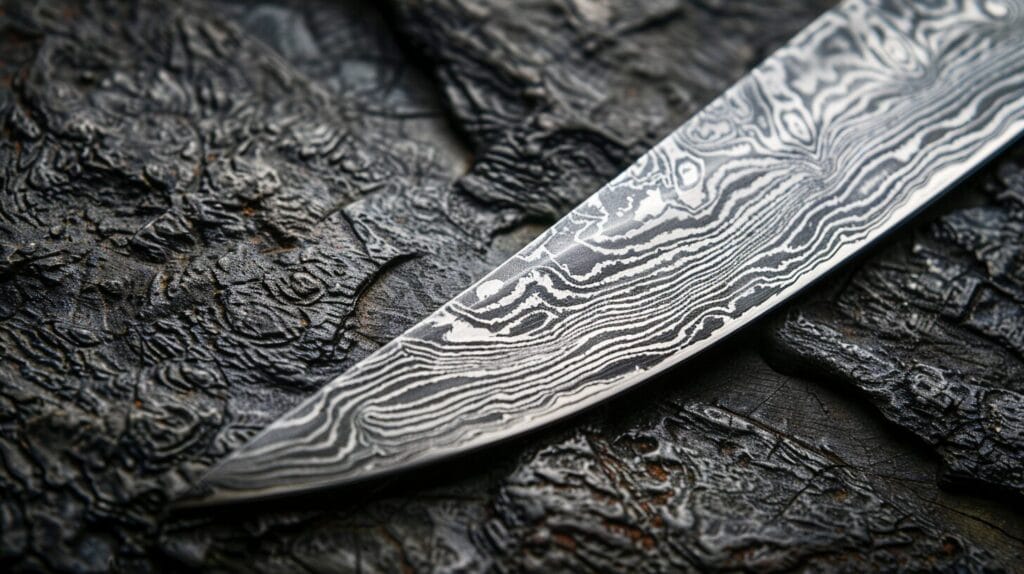
Damascus steel is easily distinguished by its captivating watery patterns. The swirling designs on Damascus steel items resemble flowing water or wood grain, creating a mesmerizing visual effect. These patterns aren’t just surface decorations but actually run through the entire metal, showcasing the complex forging process involved in making authentic Damascus steel.
The contrast in patterns is achieved by using different steel alloys during forging. Light areas are typically high-carbon steel, while darker regions consist of lower-carbon or nickel alloy steels. Various pattern styles like ladder, rose, and twist patterns offer a unique and enchanting visual appeal.
The flowing patterns are a key feature of Damascus steel, enhancing its beauty and transforming blades and weapons into both functional tools and exquisite works of art that highlight exceptional craftsmanship.
How is Damascus steel made?
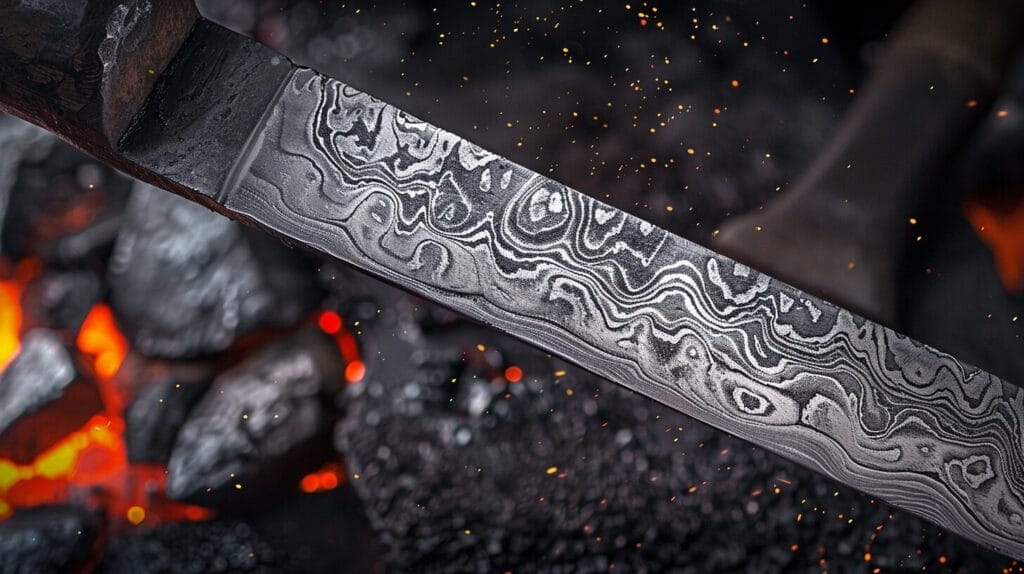
Preparing the Billet
When preparing the billet for Damascus steel, you need to stack alternating layers of different steel types, such as high-carbon steel and low-carbon or nickel alloy steel. These layers are forge welded together into a solid billet or block. To ensure a strong and durable final product, attention to detail and precision is crucial in the process.
Here are some key points to keep in mind:
- Selection of Steel Types: Choosing the right combination of high-carbon and low-carbon or nickel alloy steel is vital for creating the distinctive patterns and properties of Damascus steel.
- Layering Technique: Properly arranging the layers of steel to achieve a uniform distribution and desired pattern in the final blade.
- Forge Welding: Skillfully welding the stacked layers together through heat and pressure to create a cohesive billet.
- Temperature Control: Maintaining the correct forging temperature is essential to prevent the steel from becoming brittle or losing its unique properties.
- Hammering Method: Applying precise hammering techniques to consolidate the layers without causing delamination or other defects.
Folding and Welding
In the process of making Damascus steel, the billet is heated until it becomes malleable in a forge. It’s then folded over and forge welded to double the number of layers.
This folding, hammering, and welding procedure is repeated multiple times to increase the layers even further. Through this repetitive folding and welding, not only the number of layers is enhanced, but also the different steel types are effectively mixed together.
Each fold generates a unique pattern that contributes to the distinctive appearance of Damascus steel. This intricate method requires skill and patience, as the layers need to be meticulously aligned and welded together to ensure a sturdy and consistent final product.
By repeatedly folding and welding the steel, impurities are eliminated, and the carbon content is evenly dispersed throughout the billet.
Consequently, the resulting blade isn’t only visually appealing but also exceptionally robust and long-lasting, which makes Damascus steel highly sought after for its beauty and performance in knives and swords.
Drawing and Straightening
In Damascus steel production, the billet is extended lengthwise through hammering and rolling after each fold to maintain a uniform layered structure. This precise method ensures an even distribution of various steel layers, resulting in the iconic patterns associated with Damascus steel.
- Stretching the billet repeatedly aligns the layers and prevents gaps or irregularities.
- Hammering the billet lengthwise not only elongates it but also refines the layers, enhancing the strength and flexibility of the final product.
- Rolling the billet further consolidates the layers, forming a strong and cohesive unit.
Each cycle of drawing and straightening adds more layers to the billet, enhancing its intricacy and aesthetic appeal.
Modern techniques have optimized this process by incorporating machinery for precise drawing and straightening of the steel billet.
Twisting and Patterning
In modern Damascus steel making, twisting and patterning are essential techniques used to create intricate designs by combining different types of steel through forging. To achieve more complex patterns, the layered billet can be twisted or manipulated in various ways before being folded again.
By cutting, stacking, and reassembling the billets, craftsmen can produce elaborate mosaic or ladder patterns.
To illustrate the diverse patterns found in Damascus steel, consider the following common examples:
- Twist Pattern: Steel billet twisted to form captivating swirls
- Mosaic Pattern: Detailed designs resembling mosaics
- Ladder Pattern: Parallel lines creating a ladder-like appearance
- Raindrop Pattern: Teardrop-shaped designs scattered throughout
- Random Pattern: Unique and irregular designs without a specific structure
These striking patterns are crafted through expert manipulation of the steel during the forging process, resulting in the mesmerizing aesthetics that Damascus steel is renowned for.
Forging the Final Shape
Forging the final shape in Damascus steel making involves combining different steel types using modern techniques as the historical methods aren’t well understood.
The billet is heated to a high temperature for forging and then hammered into the desired form.
After forging, the blade or object is ground to refine the shape and eliminate imperfections.
Heat treating follows to enhance the steel’s hardness and durability.
Etching
In the process of etching Damascus steel, the forged piece undergoes polishing followed by immersion in an acidic solution. This crucial stage reveals the mesmerizing designs that define Damascus steel.
The acid treatment, often a blend of nitric and hydrochloric acid, selectively corrodes the steel layers at varying rates due to their diverse compositions. Consequently, layers of different steels, such as high-carbon and low-carbon steel, react distinctively to the etching process. The higher carbon content in certain layers results in darker etching, creating a striking contrast with the lighter layers. This contrast emphasizes the elaborate patterns, swirls, and waves characteristic of Damascus steel.
Etching not only showcases the steel’s hidden beauty but also infuses the final piece with depth and individuality, making each Damascus steel creation uniquely captivating.
Is Damascus steel better than other steels today?
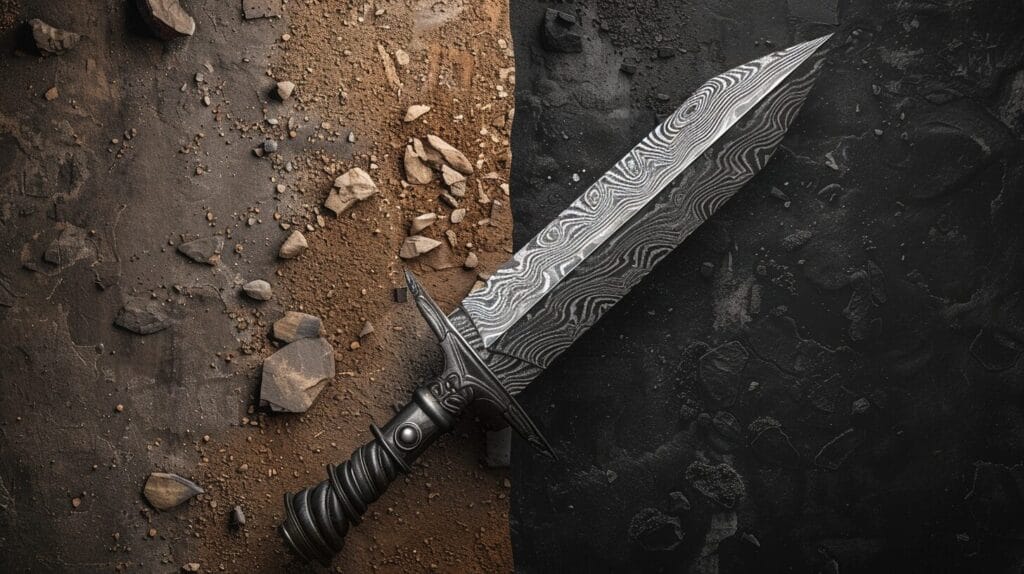
While Damascus steel has its advantages, modern steel can be just as good or even better for some purposes. Damascus steel is renowned for its unique patterns and historical significance, but modern steels offer a wide range of compositions tailored to specific needs.
Understanding the strengths of both can guide you in selecting the most suitable steel for your requirements.
Advantages of Damascus Steel
- Superior Edge Retention: Damascus steel’s high carbon content ensures sharp edges that stay sharp for long periods.
- Distinctive Patterns: The folding technique creates visually striking patterns, highly desired by collectors.
- Enhanced Strength: Layered construction provides increased strength and durability for specialized uses.
- Historical Significance: Damascus steel carries a rich history and cultural value, appealing to traditional craft enthusiasts.
- Balanced Hardness and Toughness: The layered design prevents breakage while maintaining sharpness, making it versatile for cutting tasks.
Advantages of Modern Steels
Modern steels offer advantages over Damascus steel due to their superior corrosion resistance and customizable properties.
Stainless and specialized alloy steels excel in corrosion resistance, requiring less maintenance compared to Damascus steel. Furthermore, modern steels can be designed to be lighter**, enabling the creation of faster and more agile blades when needed.
The ability to precisely control the composition of modern steels allows for tailored properties like hardness, flexibility, and edge retention, making them ideal for specific tasks. Stainless steels, in particular, are known for their low-maintenance nature, needing minimal oiling to prevent rust.
With advancements in modern steel production, blades and tools aren’t only durable and versatile but also easier to maintain and customize according to individual needs.
Where can I find Damascus steel knives or swords?
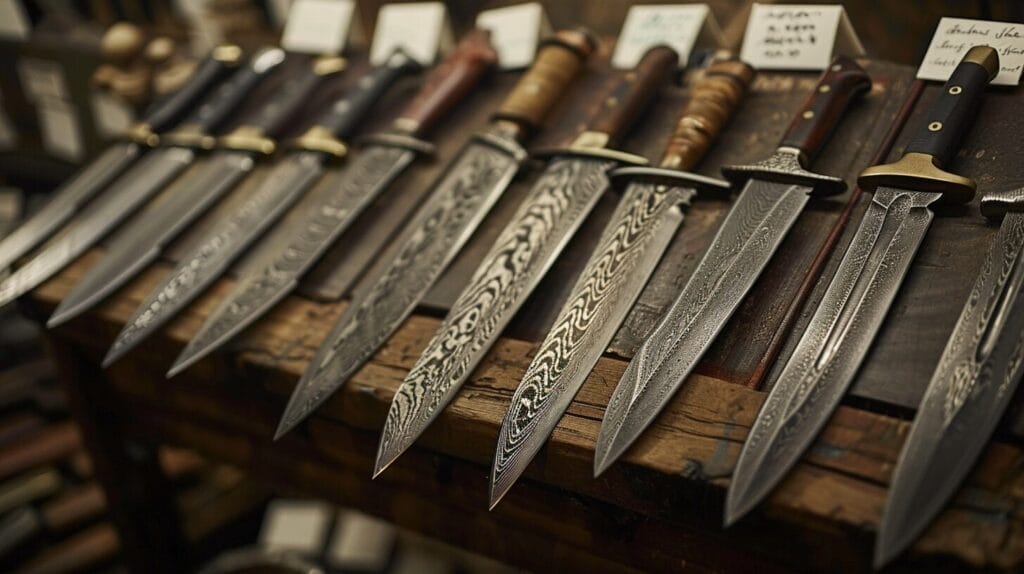
Looking for Damascus steel knives or swords? Look no further than our website, damascusknifemasters.com, where you can find a wide array of these exquisite items.
Explore our reviews and shop partnerships for a variety of Damascus steel knives and swords to choose from. Don’t miss out on exclusive deals and unique pieces available through our partners.
Stay updated on new arrivals and promotions by joining our mailing list or following us on social media.
Need assistance? Contact our customer support for personalized recommendations.
Frequently Asked Questions
What Is the Significance of the Term ‘Damascus’ in Damascus Steel?
The term ‘Damascus’ in Damascus steel signifies the historical origins of this unique metalworking technique by referencing the city of Damascus, known for producing exceptional blades. The term pays homage to its esteemed legacy.
Are There Any Drawbacks or Limitations to Using Damascus Steel?
Limitations of using Damascus steel may include the risk of rusting if not properly maintained. Despite this drawback, its distinctive patterns and durability continue to make it a highly desired material. It is essential to remember to care for it diligently to preserve its quality.
Can Damascus Steel Be Used for Everyday Kitchen Knives?
Yes, Damascus steel can be used for daily kitchen knives. They provide great durability, sharpness, and a distinctive look. With proper care and upkeep, they can serve as a valuable addition to your cooking utensils.
Is It Possible to Create Custom Designs With Damascus Steel?
Yes, it is indeed possible to create personalized designs using Damascus steel. By collaborating with experienced craftsmen, you can develop unique patterns and forms for items like knives, jewelry, or decorative pieces that highlight the elegance of this exquisite material.
Are There Any Specific Care Instructions for Maintaining Damascus Steel Items?
To preserve Damascus steel items, it is important to keep them dry and clean after each use. Avoid exposing them to harsh chemicals or excessive moisture. Regularly apply a thin layer of oil to the metal to prevent rust. Store the items in a dry place when not in use.
Conclusion
With its unmatched durability, sharpness, and intricate designs, Damascus steel continues to fascinate artisans and enthusiasts.
Despite the advantages of modern steel, the ancient craftsmanship of Damascus steel stands as a tribute to our ancestors’ creativity.
Whether you’re looking for a decorative item or a practical tool, the timeless appeal of Damascus steel is destined to endure for future generations.

